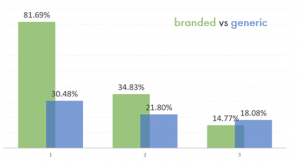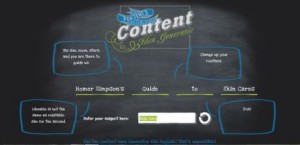We’ve all heard the phrase, “You’ve got to be in it to win it.”
Sure, it’s a bit obvious. Like any cliché, though, there’s an important truth hidden in there. As a marketer, you want your customer base to be actively participating with your brand. This means doing whatever you possibly can to involve them in a two-way conversation. One creative and effective way to do this is to have a promotional contest through one of the many social media platforms available to you. You get to choose what it will cost you and, if well organized, your return on that investment could very well surprise you.
Where to start?
Start by ascribing some goals for the contest. Are you looking to obtain more email subscribers? Get more Twitter followers? Whatever the goal may be, deciding early in the process will allow you to specifically direct the rules and structure of the contest.
For example, if you’re noticing that your Twitter reach is flagging, set up a contest through that platform. Decide early on what you’re going to do to create some buzz amongst the followers you do have – use a catchy hashtag, monitor for industry-related discussion, etc. – and encourage behavior that will promote your brand to others.
Method of Entry
Next, choose the method of entry for participants. This step is where it is most important to be aware of your platform’s rules and regulations. We’ll discuss these in more detail in a moment, but think about how useful your promotion will be if the platform you run it with decides to shut it down for a breach of their guidelines. Not so useful. This can be difficult as these guidelines can change, but all major platforms give an outline (some easier to read than others) through their website, so give it a check before finalizing the project’s structure.
Basically, though, deciding how you want participants to enter will depend on both your platform and your ascribed goals. If you are running your contest through Facebook, it’s important to refrain from “like-gating,” which was recently outlawed. Instead, you’ll want to use a third-party app (also more on these in a bit), from which you can gain their e-mail address.
Follow the Rules
Even some of the biggest companies in the world have issues when figuring out the legality of their marketing campaign. Nothing’s worse than a brilliant, creatively designed campaign that gets thwarted because rules and legalities weren’t considered early enough in the process. Don’t let this be your contest’s downfall. Think early and often about how your contest can most effectively exist within the framework of the rules of your chosen platform. Each platform will have its own. Below are some of the more important ones for each platform:
1) Facebook – Facebook recently changed the way companies are allowed to execute contests through their website. The most important recent change (enforced as of November 5th, 2014) is that incentivizing “likes” is no longer a valid method of contest entry. An effective way to get around these restrictions is to use third-party apps (a good one is ShortStack). As always, though, check with Facebook’s guidelines before going to work on your contest because they are liable to change.
Since you’ll be going through an app for your Facebook contest, be aware that certain software companies enjoy the status of being Facebook-preferred, while others don’t. This list of partners used to be housed in a directory known as the “Preferred Marketing Directory,” but this is changing sometime early 2015. So likely within the next month or so, Facebook will be replacing this list with one called the Facebook Marketing Partner Program. They explain on their site that the change should make the process of finding a third-party app much clearer and more personalized.
2) Twitter – Twitter’s guidelines are a bit less rigid than Facebook’s and also (historically speaking) less liable to change drastically without notice. The two things they do discourage are contests that incentivize posting a) the same tweet repeatedly and/or b) creating duplicate accounts to “fluff up” the participation. This shouldn’t even be considered as a tactic anyway because remember, we have to engage real customers to demonstrate real value.
3) Instagram – Instagram’s regulations are also very loose compared to Facebook’s. Refreshingly, the majority of their rules are motivated by a desire to safeguard the integrity of the photos being taken. For example, inaccurate tagging cannot be included in (nor encouraged by) your contest. In other words, Instagram is fine with you using their platform to promote a contest, but the photography that goes on along the way cannot be cheapened. This ensures that the contest will enrich both your brand and theirs.
What about sweepstakes?
Sweepstakes, unlike contests, involve a winner being randomly decided through a lottery-style drawing. Sweepstakes can be great for quickly drumming up leads and some introductory contact information for leads. The interaction being generated by a sweepstakes can be useful, but doesn’t have quite the longevity of those created by contests. This is because there isn’t much brand-building involved. Those who enter contests also do so out of a desire to participate.
The Prize
Ah, finally – that sweet payoff.
The prize may be the most important part. It’s what will attract attention to the campaign in the first place and, if you can find something that really resonates with your audience, can give vital growing potential to a fairly simple marketing strategy.
One of the first prize-related questions you’ll have to answer is whether you want it to be brand-related or not. Some companies will include a prize that is derived directly from their product: “3 free weeks of…,” “one free tour of our…,” etc., etc. Other companies are less concerned with the prize being a brand-builder in and of itself. They figure that as long as the prize promotes participation in the contest, and the contest is being held under the theoretical company banner, than the customer’s engagement with their brand is more than promoted.
I’m certainly not here to tell you that this is never true. After all, if a company wants to offer a strictly monetary prize of say, $ 5,000, the participation is bound to be off the charts. This type of offer isn’t feasible for most businesses though.
So, as a small business owner, what’s the perfect prize? It’s important to be in touch with your customer base – their buyer personas, their pain points, etc. – to be able to find a prize that both spurs them into participation and engages them with your brand.
Just like you, the people you are marketing to appreciate nothing more than a solid return on their investment. If they invest their time in a promotion that turns out to be poorly organized, that will reflect horribly on your brand as a whole. If they have a good experience though – win or lose (with an emphasis on sound structure and fair treatment) – they will feel secure in continuing their relationship with your company as a customer and eventual promoter.
Promote and Deliver
Now that your contest has infrastructure and a growing list of participants, it becomes a product in and of itself. So, what do you do with any of your other products and services? You market them, of course!
Spread the word about your contest across other platforms so the full breadth of your reach can be funneled into this particular promotion. You want as many people to get in on the action as possible, so why not use every possible avenue to let them know about the promotion?
Once you’ve promoted your contest to its full potential, you’ve got to pick a winner and get them their prize. This final step should be seen as another opportunity to promote interactivity with your brand, and not just for the winner. Upload photos or video of the prize-giving process to the platform you used to run the contest (and the platforms you used to amplify it). If the prize is delivered remotely, ask winners to submit photos to share. It will show all the participants – and all of your followers in general – that the interactive element of the campaign wasn’t just for show. It was indicative of a genuine desire to learn from and offer value to your customers.
Operate your contest with these ideals and practices at the forefront of your strategy, and the real winner will be you!
(246)
Report Post







